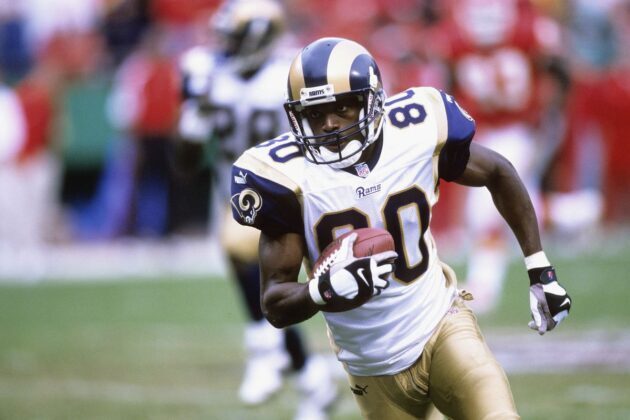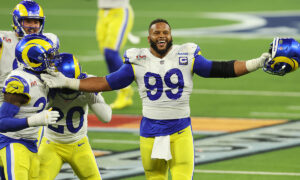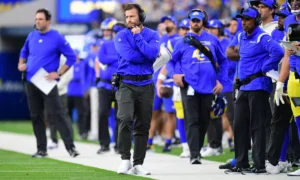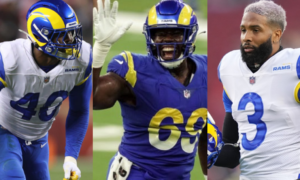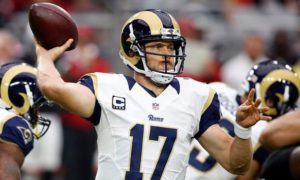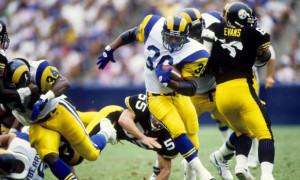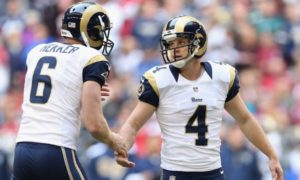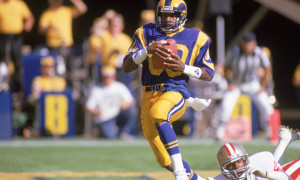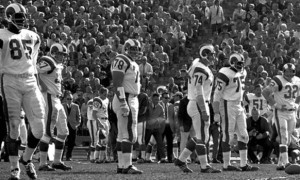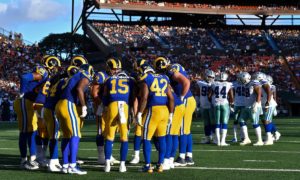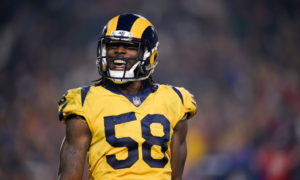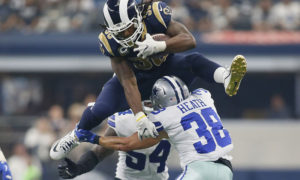The Pro Football Hall of Fame inducted Los Angeles Rams all-time receiving leader Isaac Bruce into the Hall of Fame class of 2020. Bruce retired from the NFL in 2009. He has been eligible for six years, but finally made the cut for the NFL centennial. Perhaps the wait is fitting for one of the greatest and most underrated wide receivers in the league. His numbers on the stat sheet are mind-boggling when you compare them to other great NFL receivers.
Bruce is only one of six receivers in league history to earn more than 15,000 yards in his career. He has 1,024 receptions for 15,208 yards and 91 touchdowns across 14 seasons with the Rams and two with the San Francisco 49ers. Bruce was the second all-time NFL receiving leader at the time he retired. He is currently fifth all-time league leader in receiving yards. Hall of Famer and 49ers great Jerry Rice currently leads the league with 22,895 yards. Then follows current Arizona Cardinals veteran Larry Fitzgerald (17,083), Terrell Owens (15,934) and Randy Moss (15,292). Tony Gonzalez is just under Bruce (15,127). Bruce ranks 13th all-time in NFL receptions and 12th all-time in NFL receiving touchdowns.
Bruce’s franchise numbers with the Rams are just as impressive. He is the current Rams all-time receiving leader in all three categories with 942 receptions for 14,190 yards and 84 touchdowns. To put his posted career numbers into perspective with other top Rams receivers, Bruce leads his popular counterpart and second all-time receiving leader Torry Holt by 1,449 yards and 10 touchdowns. He also leads the third all-time receiving leader Henry Ellard by 4,348 yards and 36 touchdowns. Bruce dwarfs fourth all-time receiving leader and Hall of Famer Elroy “Crazylegs” Hirsch by 7,810 yards and 31 touchdowns. To be fair though, Hirsch and Bruce are from completely different eras.
Bruce came into the league as a Los Angeles Ram. He began to shine after the move to St. Louis. His Hall of Fame induction is well-deserved, especially given his status as a two-time NFC Champion, Super Bowl XXXIV champion and for his performance during the Greatest Show on Turf era.
The College Years – 1990 to 1993
While playing football at Dillard High School in Fort Lauderdale, Florida, Bruce helped his team win the 1989 4A State Championship. He then played junior college football in California at West Los Angeles College and Santa Monica College. He eventually transferred to Memphis State (now University of Memphis) where he posted over 1,000 yards in his 1993 senior season, the first ever by a Tiger. He had a school-record 74 catches for 1,054 yards and 10 touchdowns. In his junior year in 1992, Bruce had 39 receptions for 532 yards and five touchdowns. The Los Angeles Rams picked him in the second round of the 1994 NFL Draft.
Bruce’s Pro Beginnings and The L.A. Finale – 1994
The Los Angeles Rams’ final season in L.A. was not a spectacular one for Bruce. His rookie season saw him backup starters Willie “Flipper” Anderson and Jessie Hester, but he posted 21 receptions for 272 yards and three touchdowns. One scoring pass was a 34-yarder from quarterback Chris Miller in a loss to the Atlanta Falcons. That touchdown pass was only his second completion to begin his career. His other scores were two 19-yard receptions in a win against the New York Giants and in a loss to the New Orleans Saints. The Rams finished the season with a dismal 4-12 record, last in the NFC West. Bruce showed promise as a young rookie. The Rams could never have imagined that he was about to break out with his greatest season ever.
The Forgotten Breakout Season and the New St. Louis Rams – 1995 to 1998
Bruce hit the ground running in his second season in 1995, the Rams’ first year as the St. Louis Rams. Rich Brooks was now head coach, taking over from Chuck Knox. Bruce was named starting receiver after Anderson went to the Indianapolis Colts. He had 119 receptions for 1,781 yards and 13 touchdowns. This would be his best season ever in his career with his strongest numbers. He was the Rams’ scoring leader and their most potent offensive weapon. The Rams also had their first 4-0 start since 1989 and improved their record to 7-9. To put his 1995 season stats into perspective, Bruce had 42 more receptions with 616 more yards and one more touchdown than he did during his 1999 Super Bowl-winning season. He was also number two in receiving yards for the season next to Rice. Rice overshadowed his season by leading the league with 1,848 yards.
In 1996, Bruce had another great year posting 84 catches for 1,338 yards and seven touchdowns. He led the league in receiving yards and posted back-to-back 1,000-yard seasons for the first time since Henry Ellard did it in 1990 and 1991. Unfortunately, the Rams had a 6-10 record, but Bruce ranked second in franchise scoring that year next to rookie wide receiver and punt returner Eddie Kennison. He was also voted to his first Pro Bowl.
Bruce suffered from hamstring injuries in the next two seasons in 1997 and 1998. That limited his playing time to just 17 games over two years. Head coach Dick Vermeil had just taken over the reins from Brooks and was in a serious rebuilding phase with growing pains. In the 1997 season, the Rams were 5-11. Bruce had one standout game that year against the Falcons where he tallied 10 receptions for 233 yards and two touchdowns in a 34-31 loss. In the 1998 season, the Rams suffered a 4-12 record. That year, Bruce had a great game against the Minnesota Vikings. He posted 11 receptions for 192 yards and one touchdown. His only touchdown was an incredible 80-yard pass from quarterback Tony Banks in the fourth quarter. The Rams lost the game 38-31, but the catch was also his longest career reception. Bruce’s career was about to soar in the next few seasons.
The Greatest Show on Turf and Super Bowl Era– 1999 to 2001
Bruce and the Rams began to shine as what many argue to be the greatest offense the NFL had ever seen. The 1999 season seemed bleak following starting quarterback Trent Green’s season-ending injury in the preseason. This event put backup quarterback Kurt Warner in the starting position. The rest is Rams history in the making. Warner and Bruce connected immediately. Bruce had 77 receptions for 1,165 yards and 12 touchdowns for the year. His longest touchdown pass for the season was 46 yards from Warner against the Falcons. The Rams scorched them 35-7.
His greatest game was against the 49ers. Bruce had five catches on just six targets for 134 yards and four touchdowns. He caught all four touchdown passes from Warner in a 42-20 route. His longest reception of that game was a 45-yard pass giving the Rams a 21-3 lead. It was one of three touchdowns for Bruce in just the first quarter. He also scored the final touchdown of the game: a 42-yard pass in the beginning of the fourth quarter.
Bruce had no touchdowns against the Cincinnati Bengals, but he totaled his most yardage in a game for the season. He earned 152 yards averaging 25.33 yards per catch.
The Rams earned a 13-3 record that year and a playoff berth. In the NFC Divisional matchup against the Vikings, Bruce hauled in a 77-yard touchdown pass from Warner to give the Rams a 7-3 lead in the first quarter. The Rams’ loaded passing game earned them a 49-37 win, sending them to the NFC Championship.
In the NFC Championship against the Tampa Bay Buccaneers, Bruce did not have a strong showing. He only had three receptions for 22 yards. The Bucs defense made it a low-scoring game, and the only touchdown by the Rams was a 30-yard pass from Warner to Ricky Proehl in the fourth quarter. The Rams won 11-6 and were on their way to Super Bowl XXXIV to meet the Tennessee Titans.
In the Super Bowl, Bruce grabbed his famous 73-yard touchdown pass from Warner in the fourth quarter to give the Rams a 23-16 lead with 1:54 left. He had a stellar performance with six catches for 162 yards and one touchdown. Bruce helped the Rams get their first ever Lombardi Trophy. He led all receivers in yardage. Holt came next with seven receptions for 109 yards and one touchdown.
Vermeil retired right after the Super Bowl win and offensive coordinator Mike Martz became the new head coach that year. Martz would create an even more potent and competitive offense for the next two seasons.
In 2000, Bruce also had an incredible season. He had just re-signed with the Rams on a 7-year, $42 million contract extension. His numbers were even better than the year before. He had 87 receptions for 1,471 yards and nine touchdowns. Bruce earned 10 more receptions and 306 more yards than in 1999, but he had three less touchdowns. His longest scoring reception was a 78-yard bomb from Warner against the 49ers to tie the game 17-17. The Rams beat the Niners 41-24. They had a 10-6 record for the season and played the Saints in the Wild Card playoffs. Bruce scored first with a 17-yard pass from Warner in the first quarter giving them a 7-0 lead. Unfortunately, the Rams lost 31-28.
They returned to the Super Bowl in the 2001 season to face the New England Patriots and their fresh-faced quarterback Tom Brady. The Rams had a 14-2 record, their best in the team’s history. For the season, Bruce had 64 receptions for 1,106 yards and six touchdowns. He had one touchdown in the NFC Championship against the Eagles. It was a 5-yard pass from Warner to put the Rams on the board in the first quarter. The Rams beat the Eagles 29-24. Unfortunately, they lost Super Bowl XXXVI 20-17, unbeknownst to them, creating a dynasty. Bruce had a mediocre showing against the Patriots with five receptions for 56 yards.
The Franchise Decline but Still Setting Records – 2002 to 2007
In the 2002 season, Bruce again, put up some strong stats. He had 79 receptions for 1,075 yards and seven touchdowns. He was second in scoring next to running back Marshall Faulk. Faulk had eight touchdowns and Holt had more reception yards that season. The Rams regressed to 7-9 with no playoff berth. Warner was replaced by Marc Bulger as the starter due to injury.
In 2003, the Rams came back with a winning 12-4 record. They made it to the NFC Divisional round, but lost to the Carolina Panthers 29-23. That same Panthers team lost to the Patriots in Super Bowl XXXVIII, giving New England their second Super Bowl win in three seasons. That season, Bruce had 69 catches for 981 yards and five touchdowns. He had his best game in the regular season against the Panthers with seven receptions for 126 yards.
In 2004, Bruce was the Rams’ second best receiver next to Holt. Warner had been traded to the New York Giants that season. The Rams had an 8-8 record but did make the playoffs. They were destroyed by the Falcons, 47-17 in the NFC Divisional round. Bruce had 89 catches for 1,292 yards and six touchdowns for the season.
In 2005, the Rams’ record was a dismal 6-10. Bruce’s numbers were the lowest they had been since the 1998 season. He had 36 receptions for 525 yards and three touchdowns. Second-year running back Steven Jackson led the Rams in scoring that season with 10 touchdowns. Holt led in receiving again with 102 catches for 1,331 yards and nine touchdowns.
Bruce’s last 1,000-yard season came in 2006. He had a total of eight 1,000-yard seasons throughout his career. The Rams had another 8-8 record and new head coach Scott Linehan replaced Martz. The Rams would see a serious decline in the next three seasons. Bruce did shine with 74 catches for 1,098 yards and three touchdowns that year. He also continued to make those around him great. Jackson had 13 rushing touchdowns and Holt had 10 receiving touchdowns. Receiver Kevin Curtis also had four touchdowns.
In the 2007 season, the Rams were on a downward spiral. They saw their worst record since 1991 at 3-13. Bruce’s numbers took a hit compared to the previous season. He had his lowest yards per reception average since his rookie season with 13.3. He still posted 55 receptions for 733 yards and four touchdowns. This would be his last season as a Ram.
Joining the Niners and Retirement – 2008 to 2009
Bruce would not take a pay cut in 2008 and was released by the Rams. He signed a 2-year contract for $6 million with the 49ers and was reunited with his former offensive coordinator and head coach Martz. During Bruce’s first season with the Niners, he had 61 catches for 835 yards and seven touchdowns. He was the leading team receiver that year in receptions, yards and touchdowns. It was the most touchdowns he had since 2002. In a loss to the Dallas Cowboys, Bruce had eight receptions for 125 yards and one touchdown. In a win over the Seattle Seahawks, he had four receptions for 153 yards.
In his final football season in 2009, Bruce only played in 10 games due to an injury. He had his lowest numbers in his career with 21 receptions for 264 yards. Between the 2008 and 2009 seasons, Bruce totaled 82 catches for 1,099 yards and seven touchdowns. In classic Bruce fashion, he mentored younger players while inactive during part of his last season. The Niners traded Bruce to the Rams in 2010 so he could officially retire as a Ram.
Bruce will now enjoy a place in Canton as one of the greatest receivers in NFL history. His contributions to the Los Angeles/St. Louis Rams were memorable. He leads the franchise in receiving stats, but also made players around him great. He displayed this throughout his entire career with the Rams and even when traded to the NFC West divisional rival 49ers.
Bruce’s famous touchdown helped the Rams earn their first Super Bowl win in franchise history. He also helped create one of the most powerful offenses the NFL has ever seen. Bruce is known for his humanity on-and-off the field and is well-known for his non-profit work. His Hall of Fame induction was long overdue, but fans will appreciate a late entry for the league’s historic 100-year milestone.
Sources: NFL.com, Pro-football-reference.com, Profootballhof.com, Therams.com, Wreg.com
You can follow Erik Ho on Twitter @EHoinSDLVLA. Be sure to follow Rams Talk on Twitter @TalkRams.

